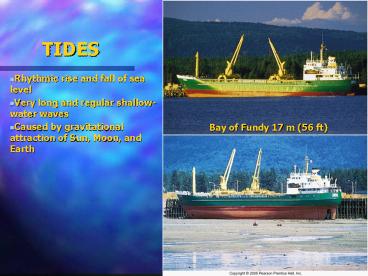TIDES - PowerPoint PPT Presentation
1 / 13
Title: TIDES
1
TIDES
- Rhythmic rise and fall of sea level
- Very long and regular shallow-water waves
- Caused by gravitational attraction of Sun, Moon,
and Earth
Bay of Fundy 17 m (56 ft)
2
Tide-Generating Forces
- Barycenter (center of mass) between Moon and
Earth - Mutual orbit due to gravity and motion
- Earth-Moon system rotation.
- The center of mass (barycenter) of the Earth-Moon
system moves in a nearly circular orbit around
the Sun. - If a ball with a string attached is swung
overhead, it stays in a circular orbit because
the string exerts a centripetal (center-seeking)
force on the ball. If the string breaks, the
ball will fly off along a straight path along a
tangent to the circle.
3
Gravitational Forces
- Every particle attracts every other particle
- Gravitational force is proportional to the
product of masses and inversely proportional to
square of separation distance - Fg G(m1m2)/d2
Gravitational forces on Earth due to the Moon.
The gravitational forces on objects located at
different places on Earth due to the Moon are
shown by arrows. The length and orientation of
the arrows indicate the strength and direction of
the gravitational force. Z zenith N nadir
4
Centripetal Forces
- Center-seeking force
- Tethers Earth and Moon to each other
- Fc mv2/r
If a ball with a string attached is swung
overhead, it stays in a circular orbit because
the string exerts a centripetal (center-seeking)
force on the ball. If the string breaks, the
ball will fly off along a straight path along a
tangent to the circle.
Centripetal forces required to keep
identical-sized particles in identical-sized
orbits as a result of the rotation of the
Earth-Moon system around its barycenter. Note
that the arrows are all the same length and are
oriented in the same direction for all points on
Earth. Z zenith N nadir
5
Resultant Forces
- Resultant forces differences between
centripetal and gravitational forces - Tide-generating forces are horizontal components
(tangent to Earths surface)
Ftide ? 1/d3
Red arrows indicate centripetal forces (C) which
are not equal to th black arrows that indicate
gravitational forces (G). The small blue arrows
show resultant forces.
6
Tidal Bulges (lunar)
- Small horizontal forces push seawater into two
bulges - Opposite sides of Earth
- One bulge faces Moon
- Other bulge opposite side Earth
As Earth rotates, it carries various locations
into and out of the two tidal bulges so that all
points on its surface (except poles) experience
two high tides daily.
7
Tidal Bulges (lunar)
- Moon closer to Earth so lunar tide-producing
force greater than that of Sun - Ideal Earth covered by ocean
- Two tidal bulges
- Two high tides, 12 hours apart
- High tide flood tide, seawater moves on shore
- Low tide ebb tide, seawater moves offshore
- LUNAR DAY (TIDAL DAY)
- Moon orbits Earth
- 24 hours 50 minutes for observer to see
subsequent Moons directly overhead - High tides are 12 hours and 25 minutes apart
8
Tidal Bulges (solar)
- Similar to lunar bulges but much smaller
- Moon closer to Earth
- New/full moon constructive interference - tidal
range greatest spring tide - Quarter moons destructive interference - tidal
range least neap tide - Time between spring tides about two weeks
- Tidal Cycle
- 29.5 days (lunar month)
syzygy
quadrature
9
Complicating Factors
- Angular distance of Moon or Sun above or below
Earths equator (declination) - Sun to Earth max 23.5o N or S of equator
- Rotation axis 23.5 to ecliptic
- Moon to Earth max 28.5o N or S of equator
- Plane of Moons orbit tilted 5 wrt ecliptic
(23.5 5) - Shifts lunar and solar bulges from equator
- Unequal tides
10
Complicating Factors
- distance between Earth and Sun varies over the
course of a year - Perihelion max tidal ranges (January)
- Aphelion min tidal ranges (July)
- Distance between Earth and Moon varies over 27.5
days - Perigee max tidal ranges
- Apogee min tidal ranges
11
Idealized Tides
- Unequal tides (unequal tidal ranges)
- Two high tides/two low tides per lunar day
- Six lunar hours between high and low tides
Tide every 6 hours at 28N latitude when
declination of Moon is 28N
Tide curves for 28N, 0 and 28S latitude during
a lunar day.
12
Real Tides
- Earth not covered completely by ocean
- Continents and friction with seafloor modify
tidal bulges - Tides are shallow water waves with speed
determined by depth of water (avg 700 km/hr) - Tidal bulges cannot form (too slow)
- Tidal cells rotate around amphidromic point
- Cotidal lines
- Tide wave rotates once in 12 hours
- CCW in Northern Hemisphere
13
Tidal Patterns
- Diurnal
- One high tide/one low tide per day
- Shallow inland sea areas Gulf of Mexico, SE Asia
- Period 24 hr 50 min
- Semidiurnal
- Two high tides/two low tides per day
- Tidal range about same
- Atlantic Coast
- Period 12 hr 25 min
- Mixed
- Two high tides/two low tides per day
- Tidal range different
- Most common
- Pacific Coast
- Period 12 hr 25 min































